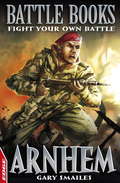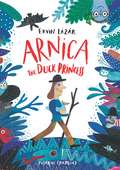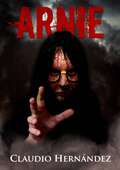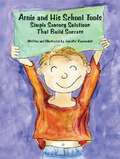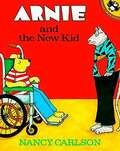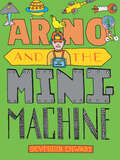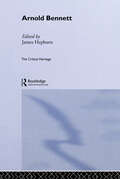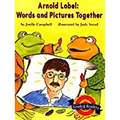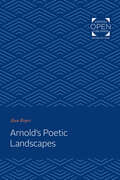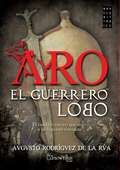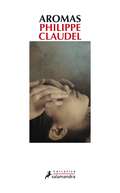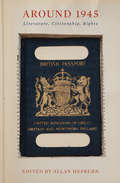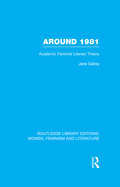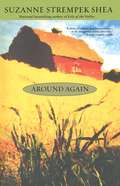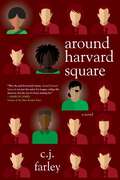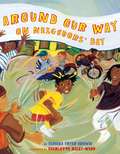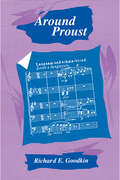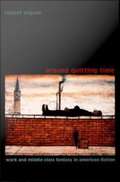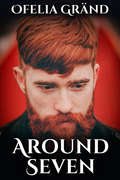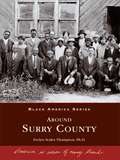- Table View
- List View
Arnhem: Fight Your Own Battle (EDGE: Battle Books #2)
by Gary SmailesTake up your weapons and prepare to fight your own battle in these all-action, interactive adventures, in which you take part in epic battles from throughout history.It is 1944 and Europe is still in the iron claw of Nazi German forces. In an attempt to end the war, British leaders have a plan to send elite troops deep behind German defences to capture key targets, including bridges. You are a Lieutenant in the 2nd Parachute Battalion. You must command your men forward through enemy territory and reach the bridge in the Dutch town of Arnhem. You must hold the bridge at any cost...
Arnica, the Duck Princess
by Ervin LazarA hilarious Hungarian classic children's story about true love, friendship and what happens when a witch turns your fiancée into a duck.Princess Arnica is so sweet and gentle that when she smiles even wolves and bears forget their fierceness. Everyone loves her, but she loves only Poor Johnny. Luckily, he loves her too, and even more luckily she has a very sensible king for a father, who is happy for her to marry whomever her heart desires. So, no problems then?Well, maybe just one - The Witch with a Hundred Faces has cast a spell on Arnica and Johnny which means that one of them, at any one time, must always be a duck, and the other human! Who can help them? Only the Seven-headed Fairy. Will they be able to find her? You'll just have to read the book and find out!
Arnie
by Claudio HernándezArnie Hammer was strange and since he was born, he revealed to the world that something inside him had come into this world. Chris succumbs to his friendship and discovers the power of Telepathy in Arnie. In his nightmares he sees an evil Arnie that always says; I know what you need. Chip and his bouncers are after Arnie until they are responsible for an act Arnie will never forgive. The new phrase is; Things are fine like this. Then, Chris further finds out. that he has telekinetic powers and revenge is about to begin but he can't stop it until Arnie finally rests and lives his life elsewhere. Being him again.
Arnie and His School Tools: Simple Sensory Solutions That Build Success
by Jennifer VeenendallThis text describes an exuberant little boy who had difficulty paying attention in class and doing his school work until he was equipped with the tools to accommodate his sensory needs. This book describes some of the sensory tools and strategies he uses at school and home to help him achieve an optimal level of alertness and performance. Image descriptions present.
Arnie and the New Kid
by Nancy CarlsonEverybody at school is a little bit afraid of Philip because he's different from them. But only Arnie teases Philip. Then, one day Arnie's teasing gets out of hand and leads to an accident that keeps Arnie off his feet-just like Philip. It's not long before Arnie discovers that you can be different and still be a lot alike-and that's what being friends is all about. Picture description are included. This file should make an excellent embossed braille copy.
Arnie and the Stolen Markers
by Nancy CarlsonAfter spending his allowance at Harvey's Toy Shop, Arnie steals a set of markers and suffers the consequences of his action. Other books by this author are available in this library.
Arnie the Doughnut (The Adventures of Arnie the Doughnut #1)
by Laurie Keller<p>At first glance, Arnie looks like an average doughnut―round, cakey, with a hole in the middle, iced and sprinkled. He was made by one of the best bakeries in town, and admittedly his sprinkles are candy-colored. Still, a doughnut is just a doughnut, right? <p>WRONG! Not if Arnie has anything to say about it. And, for a doughnut, he sure seems to have an awful lot to say. Can Arnie change the fate of all doughnuts―or at least have a hand in his own future? Well, you'll just have to read this funny story and find out for yourself.</p>
Arno And Sophie Fly Back To Scotland
by Jennifer LaidlawIn this sequel to Jennifer Laidlaw’s The Adventures of Arno and Sophie, a year has passed since Arno and Sophie left Scotland to go and live in the south of France. Although they love it there, Sophie is missing her friends back in the Scottish village of Drumoig. They hatch a plan to return to Scotland for a holiday and celebrate Sophie’s birthday at the same time. Their two cousins Zoe and Hugo decide to go with them. Thus begins another adventure, as Arno plans a journey that will take them back to Scotland via a different route, flying over many towns and cities they have never visited. Top of the list is the capital of Scotland: Edinburgh.
Arno and the MiniMachine
by Seymour ChwastA prescient and humorous tale of a boy's futuristic life gone haywire with the interruption of ... nature.GO BACK TO YOUR CLASS, says the MiniMachine.The brightly moving thing flutters into Arno's hand. It feels warm. Attached to a foot is a label, reading: BIRD.Two hundred years in the future, Arno's pre-programmed, machine-controlled day takes an unexpected turn when nature intercedes. Arno wakes each morning when his personalized "MiniMachine" tells him it's time. The MiniMachine squawks at him all day: "Eat your Instant Mealtime," "Wait for the school jet," "Go to your electric tuba lesson," "Do not step off the Power Path"..... But Arno's curiosity and a little yellow bird lead Arno off his pre-programmed track. "Go Back to Your Class!" squawks the MiniMachine with increasing alarm. Arno's mischievousness will delight young readers. And Seymour Chwast's illustrations, including his Seuss-like mechanical inventions, are both charmingly old-fashioned and presciently futuristic. A gentle corrective to our infatuation with electronics, Arno and the MiniMachine is a sweet reminder of the joy of nature and following one's own path.
Arnold Bennett
by James HepburnThis set comprises fory volumes covering nineteenth and twentieth century European and American authors. These volumes will be available as a complete set, mini boxed sets (by theme) or as individual volumes. This second set compliments the first sixty-eight volume set of Critical Heritage published by Routledge in October 1995.
Arnold Lobel: Words and Pictures Together
by Joelle CampbellHoughton Mifflin Reading Leveled Readers: Focus On Poet 2.1.4. Arnold Lobel: Words and Pictures Together by Joelle Campbell.
Arnold's Poetic Landscapes
by Alan RoperOriginally published in 1969. Alan Roper studies the degree to which Arnold achieved a unity of human significance and literal landscape. If landscape poetry is to rise above the level of what Roper calls "country contentments in verse," the poet cannot think and describe alternately; his thinking and describing must be a part of one another. That Matthew Arnold was aware of the difficulty in achieving the necessary unity becomes clear in his own criticism, which Roper examines along with a large and representative number of Arnold's poems. Considering the latter roughly in the order they were published—except for a fuller analysis of Empedocles on Etna, "The Scholar-Gipsy," and "Thyrsis"—Roper follows important changes in Arnold's view of the function and nature of poetry as it emerged in the poems themselves. Basic to the author's critical method is a distinction between geographical sites and poetic landscapes. Focusing on the ways that Arnold and, to a lesser extent, the Augustan and Romantic poets before him untied thought and description, Roper adds a critical dimension to Arnold scholarship. Concerned not with the development of Arnold's ideas nor with their sources in classical antiquity and the Romantic period, he considers Arnold a self-conscious poet who, though sometimes successful, became increasingly unsuccessful in his efforts to imbue a landscape with meaning for individual or social man.
Aro, el guerrero lobo (Historia Incógnita)
by Augusto Rodríguez de la RúaEl destino del mundo se dirime en Iberia, los romanos y los cartagineses pugnan por el control del Mediterráneo. Pero el Imperio es insaciable y necesita el dominio de la península, Aro el guerrero lobo, acaudillará a los vacceos para oponerse a las todopoderosas legiones romanas. Año 210 a. C. Aro mira al futuro con optimismo: la cosecha vuelve a ser abundante por primera vez en mucho tiempo, sus rebaños son cada vez más grandes y su esposa Coriaca está a punto de parir a su primer hijo. Pero pronto reciben noticias preocupantes: los romanos, en su guerra contra los cartagineses, han desembarcado en la tierra de los ilergetas. Aro presiente que el bando vencedor no volverá a su país. Y teme que, al contrario, quieran conquistar toda la tierra que tienen por delante. Sus presagios se cumplen cuando Roma vence a Cartago y decide adueñarse de Hispania. Pasarán años antes de que se acerquen al territorio vacceo, pero finalmente los carpetanos, que viven al sur de los vacceos, les piden ayuda para defenderse de las legiones de Roma. La ambición de Coriaca, un regalo de su hermano Docio y los sueños proféticos de un anciano druida obligarán a Aro a ponerse al frente de los vacceos y acudir a la llamada de Hilerno, rey de los carpetanos. ¿Cumplirá Aro la profecía de los druidas y salvará a su pueblo?
Arogyaniketan
by Enakshi Chatterjee Tarasankara BandyopadhyayaThe theme is a clash between the old and the new, between traditional medicine and the Western system of allopathy. On a deeper level the theme is man's confrontation with death and his attempt to come to grips with it.
Aromas
by Philippe ClaudelSi prescindiéramos de las imágenes y los sonidos, nuestros recuerdos serían una sucesión de olores percibidos desde la infancia. A partir de esta original propuesta, Philippe Claudel ha reunido en esta colección de textos breves una serie de momentos rescatados de su memoria por el poder evocativo de los aromas que los acompañaron. El perfume intenso de la tierra negra, de los ríos oscuros y los bosques de abetos de su Lorena natal, la fragancia de la loción de su padre, en contraste con su ausencia en la casa inodora y vacía tras su muerte: tan solo una muestra de la infinita variedad de olores asociados a los objetos, lugares y gentes que jalonan una vida. Aromas del hogar familiar, de la adolescencia, del internado, de los primeros amores. Olores que fascinan, que incomodan, que hacen soñar, y que van conformando la identidad de un ser humano, cada uno de ellos convertido, mediante la prosa traslúcida y elegante de Claudel, en un elixir mágico que fascina por la fuerza de su pureza y sencillez. Más allá de un mero ejercicio de introspección intimista, estos textos son un homenaje a la tierra que lo vio nacer, a las personas relevantes de su vida, así como una celebración de todos aquellos instantes de plenitud con que suele regalarnos la existencia. Críticas:«Una pluma poética y sensible [...]. Un libro exquisito.»Le Figaro Magazine «La nariz de Claudel juega a ser novelista. Y en este juego, triunfa. Describe lo indescriptible, lo minúsculo, lo imperceptible, con una fluidez sorprendente. Busca la palabra exacta y también la rima, se divierte, piensa, recuerda, respira el mundo con fruición, y nos hechiza.»Le Point «Una bellísima colección [que] no dejará a ningún lector indiferente. Difícil no caer rendido ante la evocación de estos antiguos olores.»Marianne
Around 1945: Literature, Citizenship, Rights
by Allan HepburnNear the end of the Second World War, new ideas about citizenship, national identity, belonging, and rights emerged as the atrocities of the war – coupled with the dropping of atomic bombs on Hiroshima and Nagasaki – spurred writers and citizens around the world to think about their responsibilities to their fellow man. Covering British authors and contemporary fiction by migrant writers publishing at mid-century, as well as some photography from the era, Around 1945 is a collection of essays that reveals how literary texts and cultural events modeled human rights issues such as dignity, freedom, sovereignty, and responsibility. Unified by an investigation of the human and cultural aspects of universal rights, these essays show that British writers tested the parameters of citizenship and rights in novelistic form. By imagining duties and rights of citizens in hypothetical contexts, these novels expanded on the legislated entitlements and obligations that make up civic and human identity. To this day the repercussions of 1945 continue to unfold in stories about statehood, refugees, humanitarianism, displacement, and national belonging. At the same time, novels continue to imagine the human person, equal in rights and dignity before the law, yet often compromised by the political exigencies of nation-states that do not recognize legal, political, or human rights. Tracing the rippling consequences of the Second World War from 1945 through the Cold War and into the present, Around 1945 is an extraordinarily rich volume that will alter our perception of pre- and post-war British literature. Contributors include Nadine Attewell (McMaster), Mitchell C. Brown (Dalhousie), Matthew Hart (Columbia), Janice Ho (Colorado), Emily Hyde (Rowan), Peter Kalliney (Kentucky), Marina MacKay (Oxford), Melanie Micir (Washington, St. Louis), Adam Piette (Sheffield) Claire Seiler (Dickinson College), and Ian Whittington (Mississippi).
Around 1945: Literature, Citizenship, Rights
by Allan HepburnNear the end of the Second World War, new ideas about citizenship, national identity, belonging, and rights emerged as the atrocities of the war – coupled with the dropping of atomic bombs on Hiroshima and Nagasaki – spurred writers and citizens around the world to think about their responsibilities to their fellow man. Covering British authors and contemporary fiction by migrant writers publishing at mid-century, as well as some photography from the era, Around 1945 is a collection of essays that reveals how literary texts and cultural events modeled human rights issues such as dignity, freedom, sovereignty, and responsibility. Unified by an investigation of the human and cultural aspects of universal rights, these essays show that British writers tested the parameters of citizenship and rights in novelistic form. By imagining duties and rights of citizens in hypothetical contexts, these novels expanded on the legislated entitlements and obligations that make up civic and human identity. To this day the repercussions of 1945 continue to unfold in stories about statehood, refugees, humanitarianism, displacement, and national belonging. At the same time, novels continue to imagine the human person, equal in rights and dignity before the law, yet often compromised by the political exigencies of nation-states that do not recognize legal, political, or human rights. Tracing the rippling consequences of the Second World War from 1945 through the Cold War and into the present, Around 1945 is an extraordinarily rich volume that will alter our perception of pre- and post-war British literature. Contributors include Nadine Attewell (McMaster), Mitchell C. Brown (Dalhousie), Matthew Hart (Columbia), Janice Ho (Colorado), Emily Hyde (Rowan), Peter Kalliney (Kentucky), Marina MacKay (Oxford), Melanie Micir (Washington, St. Louis), Adam Piette (Sheffield) Claire Seiler (Dickinson College), and Ian Whittington (Mississippi).
Around 1981: Academic Feminist Literary Theory (Routledge Library Editions: Women, Feminism and Literature)
by Jane GallopJane Gallop’s book offers a clear-eyed and comprehensive history of feminist literary criticism. Why, she asks, have we so quickly buried 1970s feminist criticism? What lies buried there? Why do 1990s academic feminists accuse other academic feminists of being ‘academic’? Gallop takes the novel approach of structuring her inquiry around anthologies of feminist criticism: twelve important texts that have had a wide impact on more than a decade of scholarship. In reading an anthology as a whole, she typically identifies a central, hegemonic voice (usually that of the editor/s) which would organise all the voices into a unity, and then explores the resistance within that volume to such a unity. Weight is placed behind these internal differences as a wedge against the centrist drive. Around 1981 addresses briefly ‘french feminism’ and psychoanalytic feminism before focusing on its principal subject: the mainstream of feminist literary criticism, before and after its general acceptance as part of the changing institution of literary studies. This brilliantly illuminates the dilemma of the feminist critic, divided by her allegiance to both feminism and literary studies.
Around Again
by Suzanne Strempek SheaWhen Robyn Panek is summoned by her ailing uncle Pal to operate his pony ring for one final season on his Massachusetts farm, her years away form the vacation spot of her youth seem an unbridgeable gap. But she is pulled by forces stronger than memory to piece together the events of that last childhood summer -- when a dark mystery swirled about her friend Lucy Dragon. They called her crazy, and Robyn must at last uncover the truth about Lucy's sudden disappearance -- and make peace with her own first love, Frankie. Now the future of Pal's six ponies, who circle the ring five times for a dollar a ride, is as uncertain as Robyn's own, as she confronts the past she ran from so long ago.
Around Harvard Square
by C.J. FarleyRace, class, and hormones combine and combust when a Harvard freshman and his two friends attempt to join the staff of the Harpoon, the school’s iconic humor magazine. —Around Harvard Square is the winner of the NAACP Image Award for Outstanding Literary Work (Youth/Teens) “This coming-of-age novel, set in the ’90s, follows Jamaican-American Tosh Livingston and his group of friends — Lao, Meera, and Zippa — on their quest to land coveted spots on the staff of the Harvard Harpoon, Harvard’s humor magazine . . . The characters’ clever dialogue challenges privileged and stereotypical thinking.” —Publishers Weekly “In this throwback coming-of-age novel, an ensemble of freshmen on the margins struggle for self-definition amid the race and class complexities of Harvard . . . Through the whirlwind of their journey, they begin to question the purpose of jokes and the consequences of laughter — when it’s not just about the joke, but also about who’s making it and why (a significant, timely exploration as comedy culture today struggles to demarcate ethical boundaries) . . . The diverse ensemble of core characters defy and refuse reductive stereotypes . . . For those who would like to take a trip through the hallowed Harvard halls of the past, this goes out to you . . .” —Kirkus Reviews Tosh Livingston, superstar student-athlete from small-town USA, thinks he’s made it big as a rising freshman at Harvard University. Not so fast! Once on campus, he’s ensnared in a frenzied competition to win a spot on Harvard’s legendary humor magazine, the Harpoon. Tosh soon finds that joining the Harpoon is a weird and surprisingly dangerous pursuit. He faces off against a secret society of super-rich kids, gets schooled by a philosophy professor who loves flunking everyone, and teams up with a genius student-cartoonist with an agenda of her own. Along the way, Tosh and his band of misfit freshman friends unearth long-buried mysteries about the Ivy League that will rock the Ivory Tower and change their lives forever . . . if they can survive the semester. With its whip-smart humor and fast-paced narrative, Around Harvard Square will appeal to readers of all ages interested in exploring the complicated roles that race and class play in higher education.
Around Our Way On Neighbors' Day
by Charlotte Riley-Webb Tameka Fryer BrownNeighbors gather on a hot summer day for a joyful block party: Kids play double Dutch; men debate at the barber shop and play chess; mothers and aunts cook up oxtail stew, collard greens, and other delicious treats; and friends dance and sway as jazz floats through the streets. <P> A rhythmic tale that celebrates the diversity of a close-knit community, Around Our Way on Neighbors' Day will excite readers and prompt them to discover the magic of their own special surroundings.
Around Proust
by Richard E. GoodkinA study in obsession, Marcel Proust's A la recherche du temps perdu is seemingly a self-sufficient universe of remarkable internal consistency and yet is full of complex, gargantuan digressions. Richard Goodkin follows the dual spirit of the novel through highly suggestive readings of the work in its interactions with music, psychoanalysis, philosophy, and cinema, and such literary genres as epic, lyric poetry, and tragedy. In exploring this fascinating intertextual network, Goodkin reveals some of Proust's less obvious creative sources and considers his influence on later art forms. The artistic and intellectual entities examined in relation to Proust's novel are extremely diverse, coming from periods ranging from antiquity (Homer, Zeno of Elea) to the 1950s (Hitchcock) and belonging to the cultures of the Greek, French, German, and English-speaking worlds. In spite of this variety of form and perspective, all of these analyses share a common methodology, that of "digressive" reading. They explore Proust's novel not only in light of such famous passages as those of the madeleine and the good-night kiss, but also on the basis of seemingly small details that ultimately take us, like the novel itself, in unexpected directions.
Around Quitting Time: Work and Middle-Class Fantasy in American Fiction
by Robert SeguinVirtually since its inception, the United States has nurtured a dreamlike and often delirious image of itself as an essentially classless society. Given the stark levels of social inequality that have actually existed and that continue today, what sustains this at once hopelessly ideological and breathlessly utopian mirage? In Around Quitting Time Robert Seguin investigates this question, focusing on a series of modern writers who were acutely sensitive to the American web of ideology and utopic vision in order to argue that a pervasive middle-class imaginary is the key to the enigma of class in America. Tracing connections between the reconstruction of the labor process and the aesthetic dilemmas of modernism, between the emergence of the modern state and the structure of narrative, Seguin analyzes the work of Nathanael West, Ernest Hemingway, Willa Cather, John Barth, and others. These fictional narratives serve to demonstrate for Seguin the pattern of social sites and cultural phenomenon that have emerged where work and leisure, production and consumption, and activity and passivity coincide. He reveals how, by creating pathways between these seemingly opposed domains, the middle-class imaginary at once captures and suspends the dynamics of social class and opens out onto a political and cultural terrain where class is both omnipresent and invisible. Aroung Quitting Time will interest critics and historians of modern U. S. culture, literary scholars, and those who explore the interaction between economic and cultural forms.
Around Seven
by Ofelia GrändOswald Sattle has been sleeping in his Toyota Camry for the last 273 days, the exact number of days since he discovered his fiancé cheating on him. Now, out of money and out of options, he’s on his way to Nortown. Aiden, an acquaintance from his past, has offered him a job opportunity he can’t turn down, no matter how much he’d like to.Joshua Roth moved to Nortown four years ago, and he has everything he needs -- a job, friends, peace and quiet. He’s not looking for a boyfriend; no one even knows he’s gay, and he’d like it to stay that way. Everything changes when he offers Oswald a place to stay, though.Oswald looks like he wants to run away, and Josh finds himself suggesting things that will make him stay. All he wants is for Oswald to smile. Oswald doesn’t want to overstay his welcome, but nothing soothes his nerves like being with Joshua in his cabin.How long can Oswald stay before it’s time to move on again? Can Joshua have Oswald staying with him without the whole town talking about them? Probably not, but does he care?
Around Surry County (Black America Series)
by Evelyn Scales ThompsonFrom slavery in the 1800s to freedom in the 1950s, Black America Series: Around Surry County traces the footsteps of African Americans through their transition from house servants and field hands to land owners, farmers, andsuccessful small business proprietors. This detailed pictorial history celebrates and honors the strong faith, courage, and determination of the Surry County area's black community.
